In this guide, we will provide instructions on planting bare root hedging, including a detailed explanation of the ‘notch planting’ technique for smaller plants. You’ll also find our recommended care and maintenance practices to maximise the survival and successful establishment of your new bare root hedging!
Bare Root plants are grown in a field and then lifted without soil around their roots during the dormancy period, which generally runs from November to March. If you don’t intend to set the hedge immediately upon arrival, we recommend that you leave the plants in their bags and store them in a cool, frost free shed or garage. This will help to protect them from frost and wind. Just make sure to sprinkle a little bit of water on the roots every couple of days to maintain adequate moisture!
If you are unable to plant your bare root plants within one week of receiving them, we recommend that you dig a trench in a sheltered part of your garden and heel the plants into the soil to cover the roots so that they are protected. When you are ready to plant, simply lift the plants from the soil on the day that you need them.
When planting smaller bare root plants we recommend that you follow the ‘notch planting’ technique as it is a quick process that avoids digging huge planting pits that require laborious backfilling. When ‘notch planting’ you should…
1. Make sure that the roots are moist.
2. Open up a slit in the soil, push a spade few inches deep and move back and forward.
3. Slide the root of your bareroot plant into the slit, up to the nursery soil mark.
4. ‘Heel in’ tight to ensure good soil/root contact, you should have to tug the plant quite hard to remove it.
Don’t remove the hedging plants from the box or bag before you plant. Exposure to sun or drying winds may lead to root desiccation and eventual failure.
To give your new hedge the best start, we recommend using canes and guards. These accessories offer crucial protection against common predators like voles, rabbits, and deer. Beyond protection, they also provide essential support for young plants, encouraging upright growth. This support plays a significant role in boosting their survival and successful establishment.
A 5% overall failure rate is generally considered acceptable with bare root planting. When you’re planning how many trees to plant, it’s a good idea to factor in this potential rate to ensure you achieve your desired coverage.
After completion of planting, it is important that you continue to care for the plants. Adding a layer of mulch, such as wood chips, around your trees is a great way to reduce weed competition and help the soil retain moisture. For continued healthy and vigorous growth, we recommend topping up the mulch annually in the spring. By maintaining this practice in the early years following planting, you could see as much as one-third extra growth per year!
We recommend using 5 plants per metre when using our 40-60cm bare rooted hedging plants. The best way is to plant in a double staggered row.
Bare rooted plants should only be planted once they have become fully dormant, which in the UK is between November to March. This can however move by a few weeks depending on the weather.
Good soil to root contact, which is achieved by heeling in the plants firmly.
You can incorporate compost and soil improver in the planting area, one of the most efficient methods to help bare rooted plants grow is to plant in conjunction with a mycorrhizal fungi such as Rootgrow.
Yes. King and Co recommend watering in the plants once planted to settle the soil. Usually the hedge will not need additional watering until late March/April when the weather warms up and the ground begins to dry out.
King and Co are Plant Healthy Certified meaning our plants are sourced, grown and handled in the most careful and bio-secure manner.
Bare root hedging is typically a lower cost solution to creating a new hedge or infilling an existing hedge as opposed to using container grown or rootballed plants.
What is Photinia Red Robin? It’s one of the UK’s most popular evergreen shrubs, known for its bright red new growth and glossy green mature leaves. This versatile plant, also called Christmas Berry, adds year-round colour and structure to any garden. In this guide, we’ll cover what makes Photinia Red Robin so popular, how to plant it, and the best ways to care for it.
Photinia Red Robin stands out with vibrant red foliage that matures into a rich green. In April and May, it produces clusters of small white flowers, adding seasonal interest. As a hardy evergreen, it keeps its leaves all year, making it ideal for hedging, screens, or standalone garden features.
This adaptable shrub fits a wide range of garden styles. Use it to create privacy, add structure, or bring colour to formal and informal landscapes. Whether you’re planting a hedge or highlighting a feature area, Photinia Red Robin is a smart, eye-catching choice.
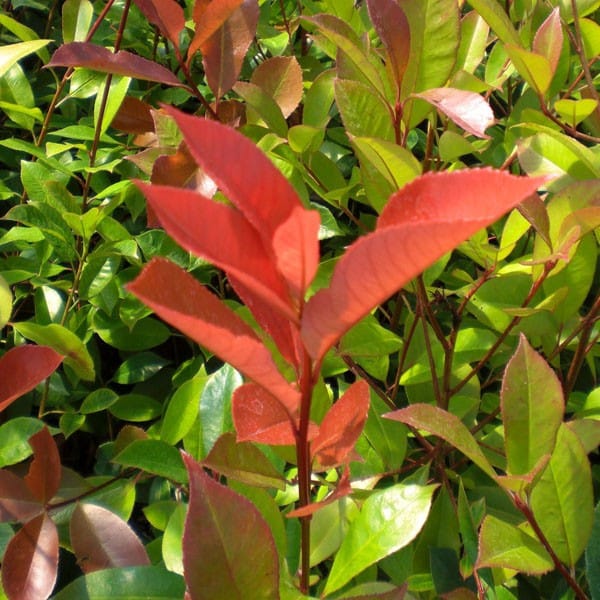
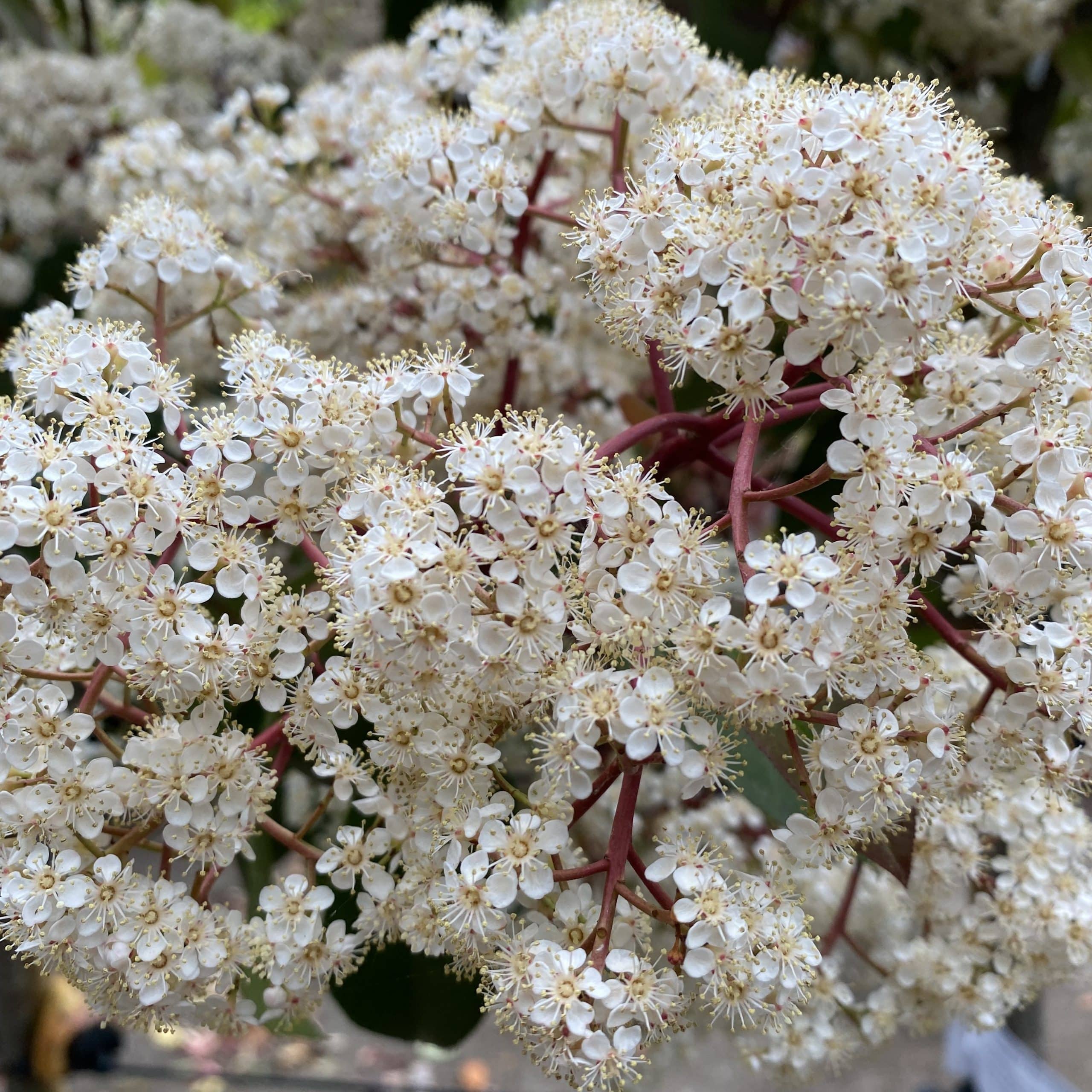
If you’re wondering what is Photinia Red Robin good for, privacy is high on the list. It is great as a hedge or standard tree to screen above fences and walls!
1. Standard Trees. These trees have a raised, bushy head, perfect for adding height without taking up much space. This foliage creates screening above the fence line to enhance privacy. Its non-aggressive root system also makes it suitable for planting near buildings. We recommend that they are positioned at 1.2-1.5m centres.
2. Hedging Plants. These plants should be planted roughly one per metre to form a dense, tidy screen. They are great option for defining boundaries, especially as their evergreen nature provides year round coverage.
3. Half Standard Trees. Ideal for smaller gardens or screening along a low wall or fence. These trees are also great for adding height and interest to smaller gardens or as a feature either side of a doorway!
Because our Photinia Red Robin plants are container-grown, you can plant them any time, just avoid extreme heat. Choose a spot in full sun or partial shade. Photinia grows well in most soil types, as long as drainage is good. Maintaining a regular watering throughout the first growing season is very important to keep the soil moist and ensure successful establishment. For more advice check out our article on watering new plants!
Photinia Red Robin is easy to maintain. It grows up to 30cm per year and reaches about 4-4.5m tall and 3m wide. Prune twice a year to shape the plant and remove dead branches. You can also trim new growth to encourage fresh red leaves. Avoid pruning after early September to protect new growth from frost.
So, what is Photinia Red Robin good for? It’s perfect for gardeners who want colour, privacy, and low-maintenance structure. Visit our nursery or browse our online catalogue to explore our range of Photinia Red Robin trees and hedges. We deliver across mainland UK and offer installation throughout Essex and nearby areas. Contact us today for expert advice and quotes.
2. Best Trees for Privacy: Before and after planting!
3. 10 Trees for Small Gardens!
4. Tree Planting Kits: Give your newly planted tree the best start!
5. How to Water Newly Planted Trees
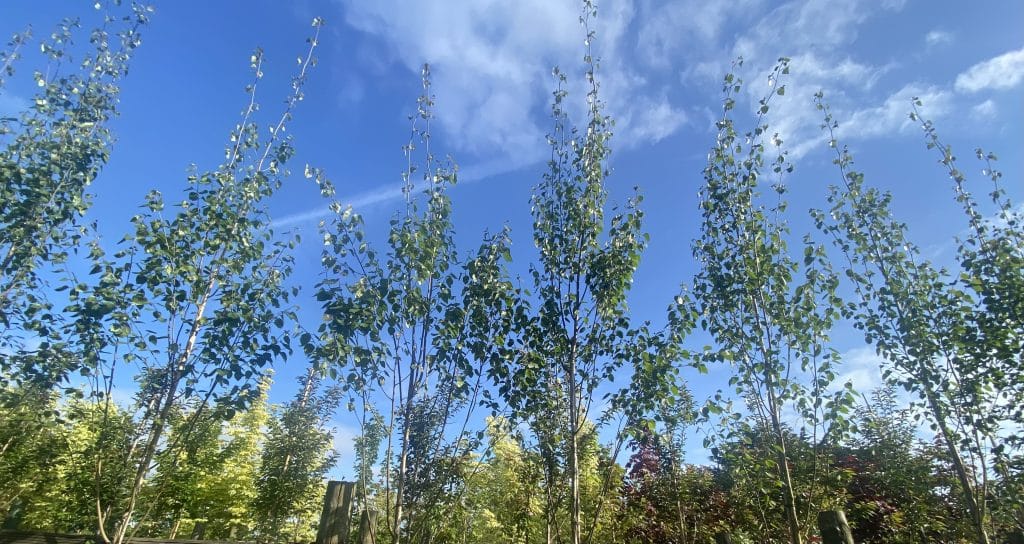
National Tree Week is the biggest annual tree celebration in the UK. Every winter, The Tree Council rallies people across Britain to plant over a million trees. Healthy trees mean healthy communities, and planting together helps us all grow stronger.
The campaign began in 1975 as a response to the Dutch Elm Disease outbreak in the 1960s, which wiped out millions of trees. The UK responded with the “Plant a Tree in ‘73” initiative. Its success led to the founding of The Tree Council, and the first National Tree Week followed two years later.
Now in its 50th year, the campaign faces a new challenge with Ash Dieback. To protect our landscapes, we must keep planting trees in parks, streets, woods, and green spaces.
National Tree Week features planting events and workshops nationwide. Schools, local groups, Tree Council members, and Tree Wardens organise activities. Visit The Tree Council’s interactive ‘Near You’ map for local events. The website also offers event tips and downloadable posters.
“With forty years of successful growth behind it, National Tree Week has become firmly rooted in the calendar of hundreds of community groups around the UK,” said Pauline Buchanan Black, Director-General of The Tree Council. “To mark the 40th anniversary of this important campaign, we want to celebrate Britain’s rich heritage of tree-planting and applaud the commitment of communities that really value their trees.”
Source: The Tree Council
It will run from 22nd November – 30th November 2025.
In this guide to tree forms we will discuss the various shapes and sizes that trees can be purchased in! Some of our most popular forms include standard trees, Trees can be purchased in various size and shapes, referred to as forms. Photinia for example can be gown as a multi-stem hedge, ornamental 1/4 standard tree, a pleached tree for screening or in standard form it will mature into a large beautiful centre piece.
Standard trees feature a straight, single trunk that is clear of branches up to about 1.8-2m. Trees with this form are ideal for creating privacy screens against neighbouring properties, obscuring overlooked windows, and hiding less desirable views from your property. To ensure your chosen tree develops into an excellent standard form, it’s important to select one with a strong, straight stem and that is provided in a sufficiently large pot.
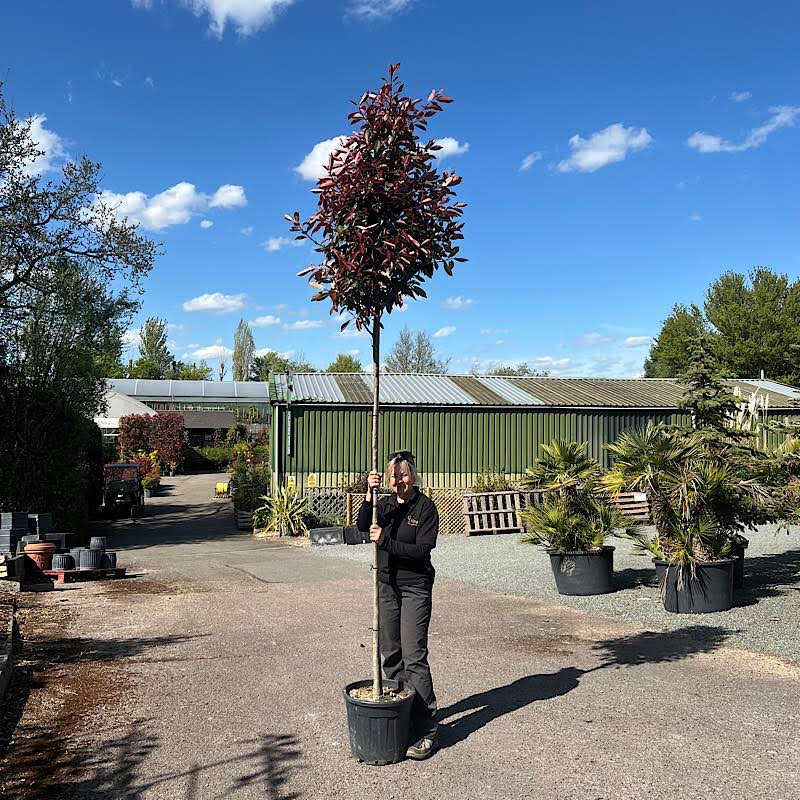

Pleached trees are a fantastic option if you’re looking to achieve a more instant impact in your landscape design. These trees feature a clear stem, usually between 1.8 and 2 meters high, and a framework of flexible shoots and foliage. They are particularly favoured for establishing narrow, elevated screens above fences or garden walls, offering both privacy and visual appeal. Beyond screening, pleached trees can also provide welcome shade and are often a key element in creative garden layouts. It’s interesting to note that the pleaching technique isn’t limited to a standard shape; trees can also be trained into various other forms like cubes, parasols, and globes, offering even greater design flexibility.
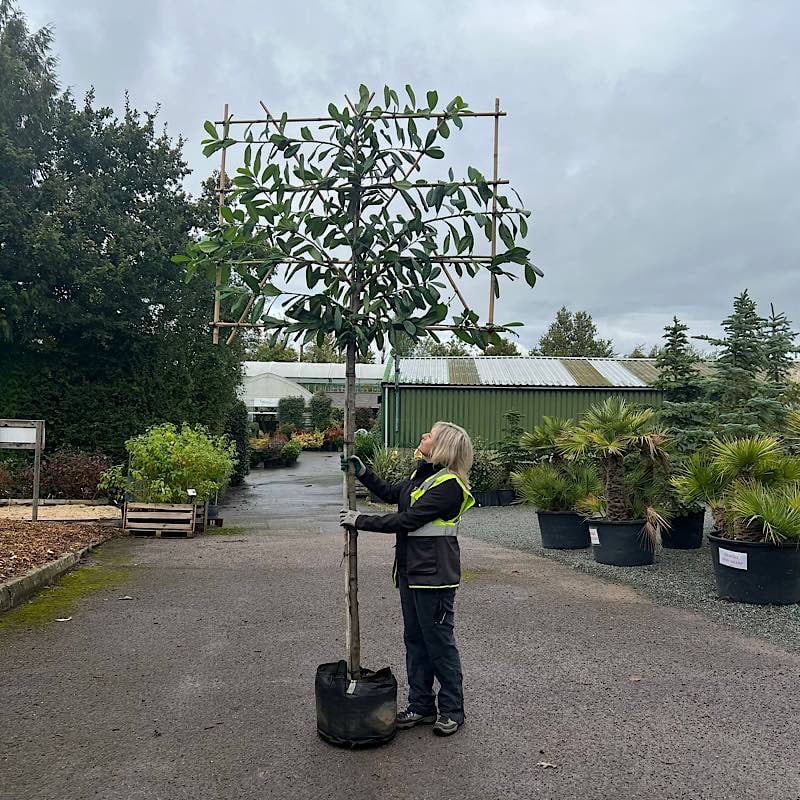
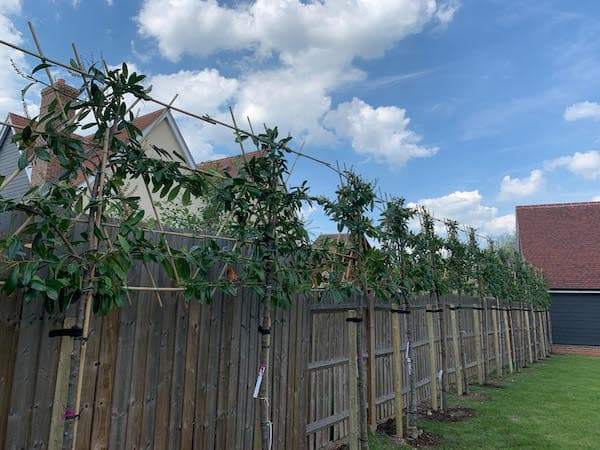
Half standard trees have a single central trunk that is clear of branches up to approximately 90-110cm from the base. They are typically available with heads of foliage measuring 40-50cm. This foliage offers versatility; clip to maintain a neat, small, and globular shape, or grow out into a larger sphere or small tree.
With their classic and attractive appearance, half standard trees are an excellent choice for a variety of landscaping purposes. They are ideal for placing beside doorways or for enhancing drives, walkways, and paths. Their form is also perfect for adding height and visual appeal to smaller gardens. When planted in a row along a low wall, they can also create a unique, low, raised hedge.
Quarter standard trees feature a single, central trunk that is clear of branches up to approximately 50-100cm from the base. Like 1/2 standards, they are highly decorative and can be planted to make an attractive feature by doorways or to add height and visual interest to other areas of the garden.
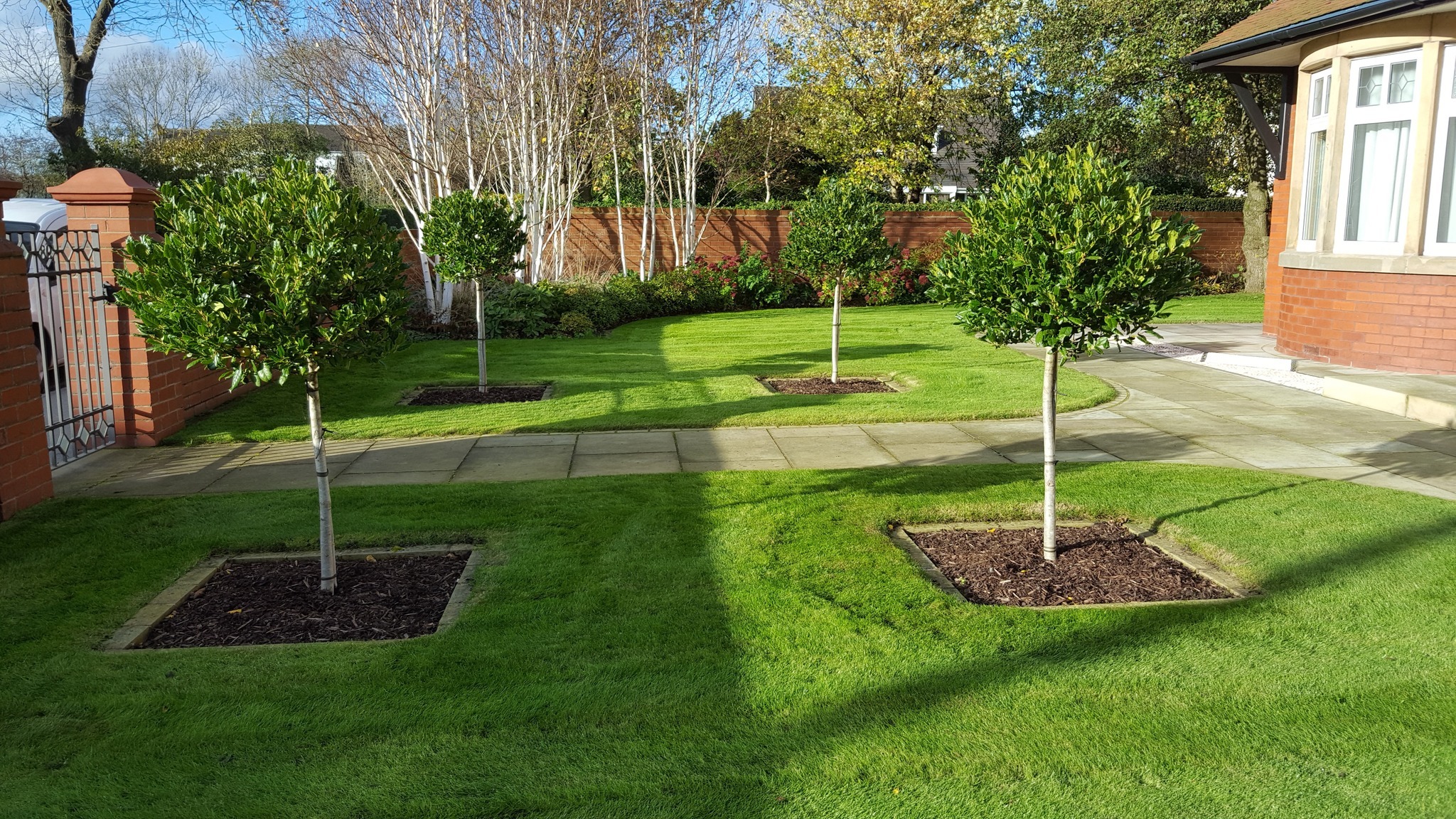
Feathered trees have a single, straight trunk with evenly spaced lateral branches that extend from the base of the tree all the way up. These trees are an excellent choice for those who appreciate natural form and structure, particularly if the goal is to establish a windbreak, noise barrier, or screen that provides coverage from ground level rather than above a fence.
Multi-stem trees are a single plant, with a number of stems growing from a single trunk near the ground. The wider base and multiple stems makes multi-stemmed trees particularly well-suited to natural screening!
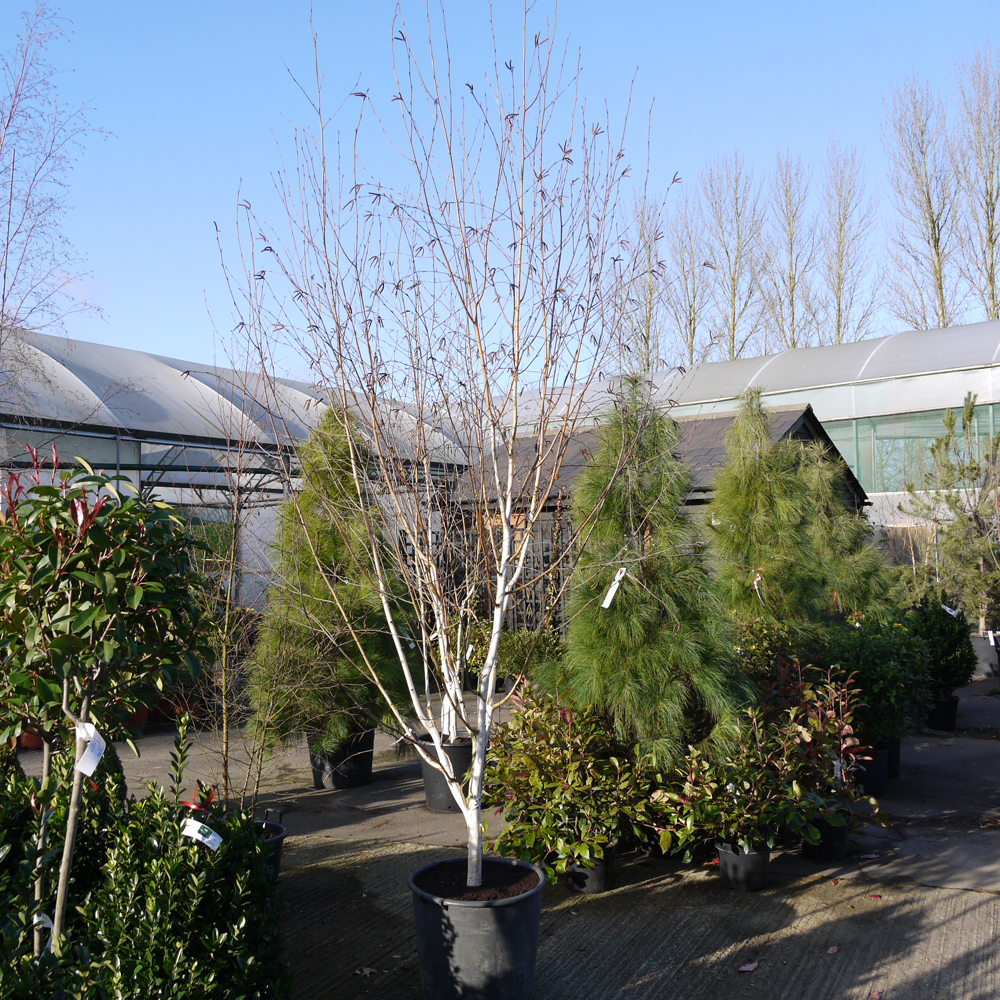
We hope this guide to tree forms has clearly explained the variety of shapes and sizes our trees are available in. For further details, please feel free to browse our comprehensive tree catalogue, visit our nursery in person, or contact us via email. We are always happy to provide additional information, pictures, and quotes if you ask for them!
In this beginners guide to planting bare root hedging and trees we will discuss the benefits of choosing bare root plants as well advice on how to plant and care for them.
Bare Root plants are plants that are sold without any soil around the roots. They are carefully lifted from the ground during their dormant season, which usually lasts from November to March. During lifting, we take great care to retain as much of the root system as possible before gently removing the surrounding soil and ensuring the roots are well-protected for transport. This method allows the plants to be kept out of the ground, making them easy and convenient to transport!
We can supply a wide selection of trees and hedging in bareroot form, sizes vary but it can be up to 2.1m in height depending on the specific species!
One of the most significant benefits of choosing bare root trees is their affordability (they can often cost less than a third of what you might pay for a container-grown plant). Additionally, because bare root plants are transported without soil or containers, they are much lighter. This reduced weight often translates to lower shipping costs compared to container-grown or root-balled trees! The low cost also means you can choose to plant more densely.
Bare Root plants are also convenient to plant as the lack of soil and weight makes planting much easier! These plants also establish quickly if there is good root/soil contact!
Once you receive your bare root plants, it’s important to protect them from drying out. We recommend leaving the plants in their bags and storing them in a cool, sheltered location such as a garage or shed, where they will be protected from frost and wind. Just make sure to sprinkle a little bit of water on the roots every couple of days to maintain adequate moisture!
If you are unable to plant your bare root plants within one week of receiving them, we recommend that you dig a trench in a sheltered part of your garden and heel the plants into the soil to cover the roots so that they are protected. When you are ready to plant, simply lift the plants from the soil on the day that you need them.
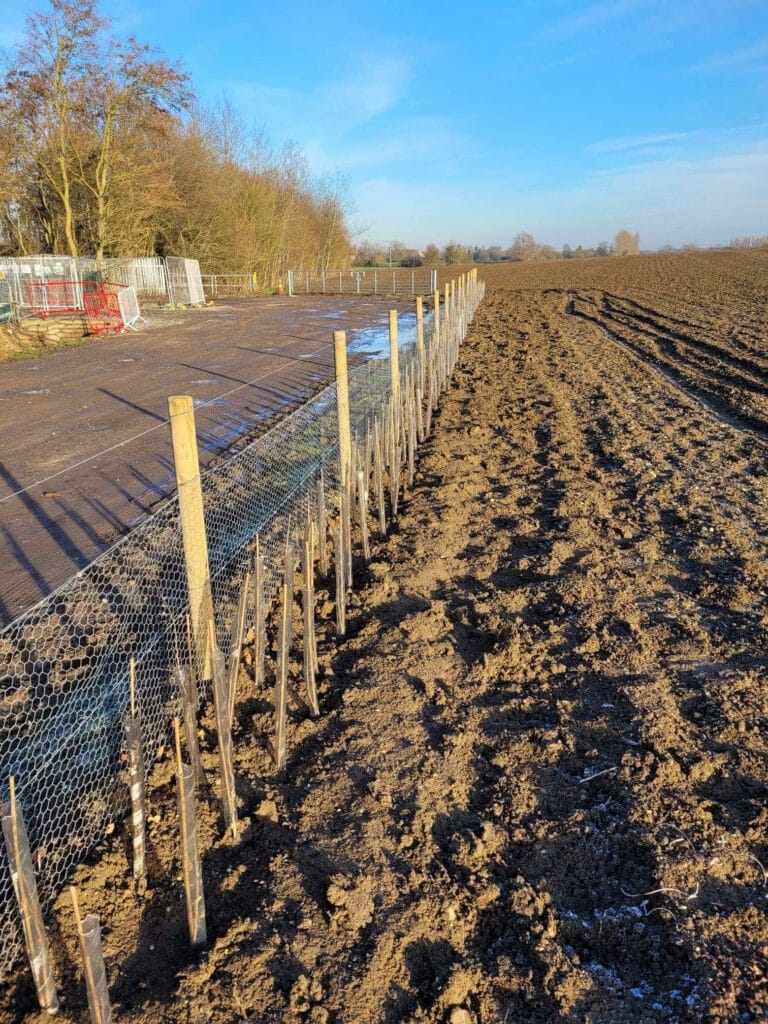
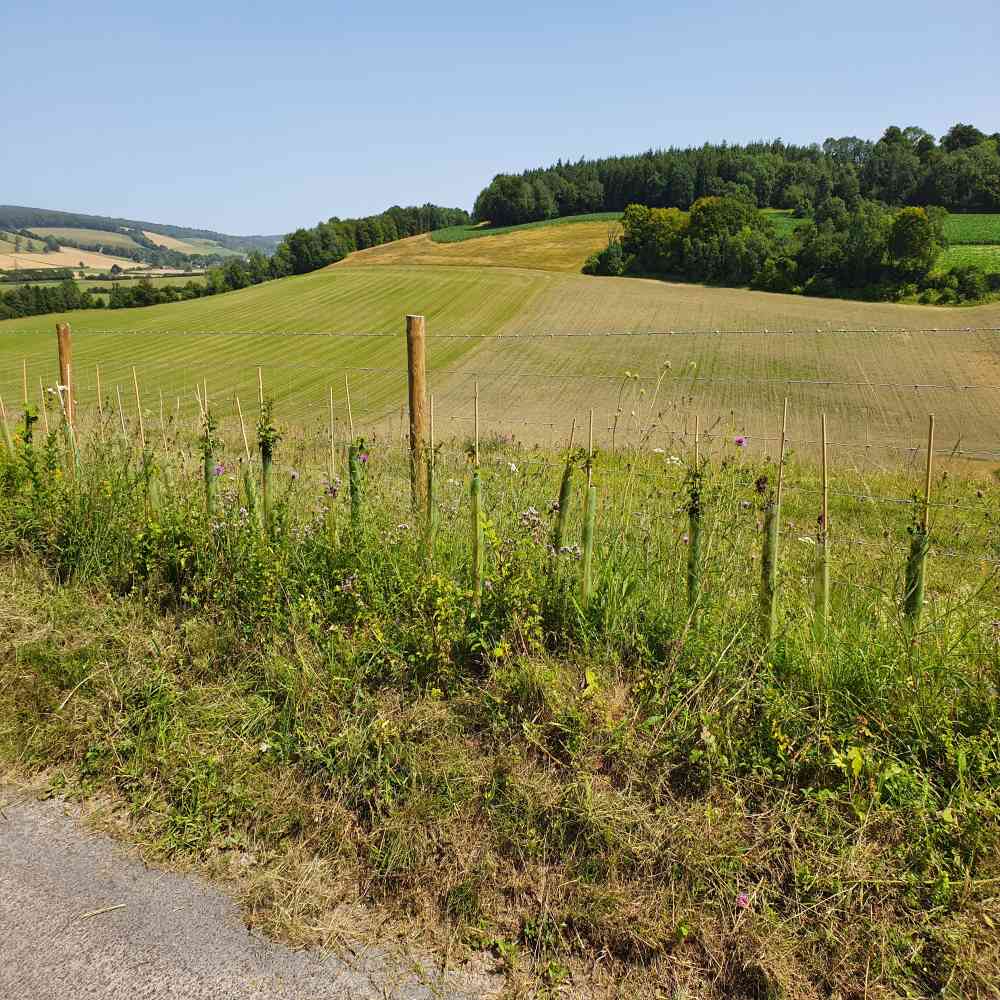
‘Notch Planting’ is a very successful method for establishing large quantities of small hedging. You just need to…
Water – Even if rain is on the way, bare root hedging and trees will need to be watered in well when planted. They will also need a regular watering schedule for at least the first year after planting.
While it’s easy to remember in the summer heat, it is also important to check the soil after any extended dry spells in winter and spring. Checking the soil regularly will help you determine if the soil is moist enough and when watering is needed. For a more convenient and reliable watering solution, consider installing an irrigation system. We offer both ‘leaky pipe’ systems and ‘Rootrain’ systems, the latter being particularly suitable for container-grown plants. We can also take care of the installation for you if you are local to the nursery!
Mulching – Adding a layer of mulch, such as wood chips, around your trees is a great way to reduce weed competition and help the soil retain moisture. For continued healthy and vigorous growth, we recommend topping up the mulch annually in the spring. By maintaining this practice in the early years following planting, you could see as much as one-third extra growth per year!
Staking – Smaller bare root trees and hedging plants can be secured with a bamboo cane, larger plants will need a wooden post and rubber tie. Staking is always beneficial as it helps to avoid root disturbance. Just remember that the stake should not exceed the height of the plant and should be positioned on the side most exposed to wind.
Protection – Protection accessories such as spiral rabbit guards or suitable tree, shrub, or deer guards can be very effective in preventing damage to the plant from animals.
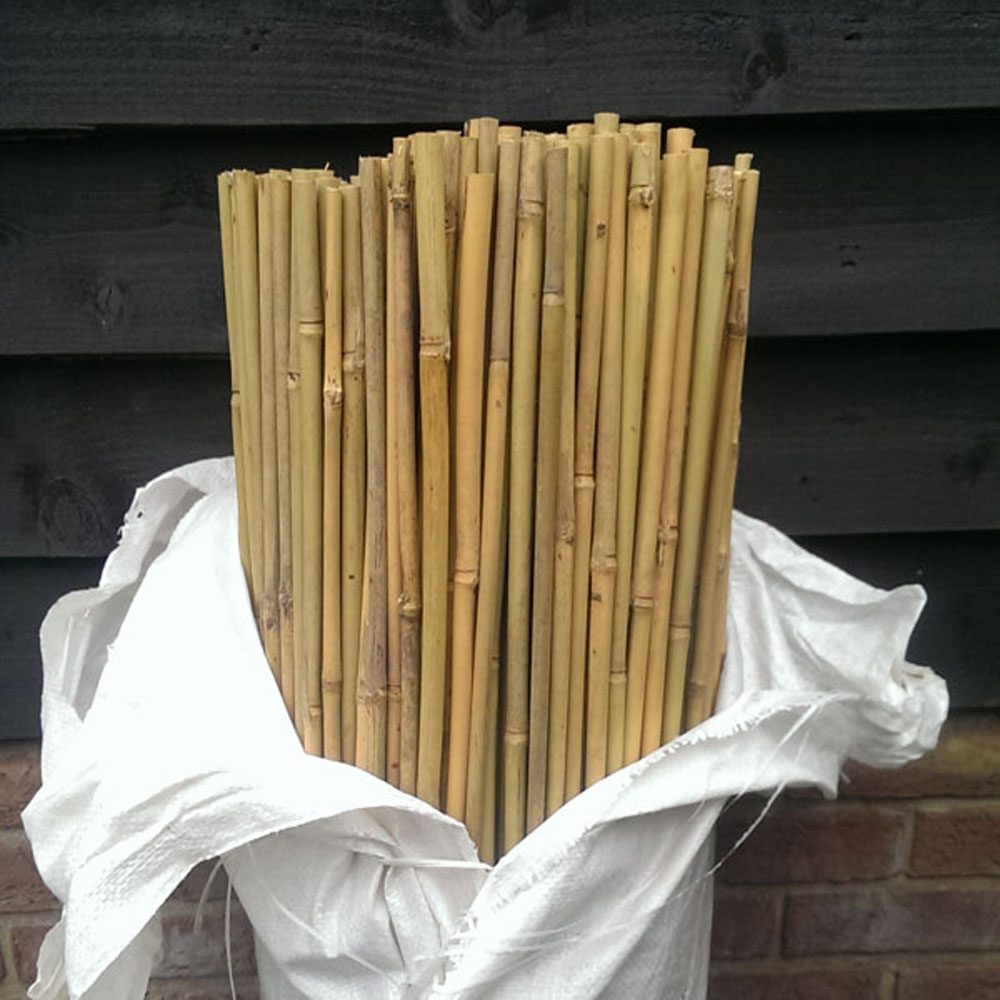
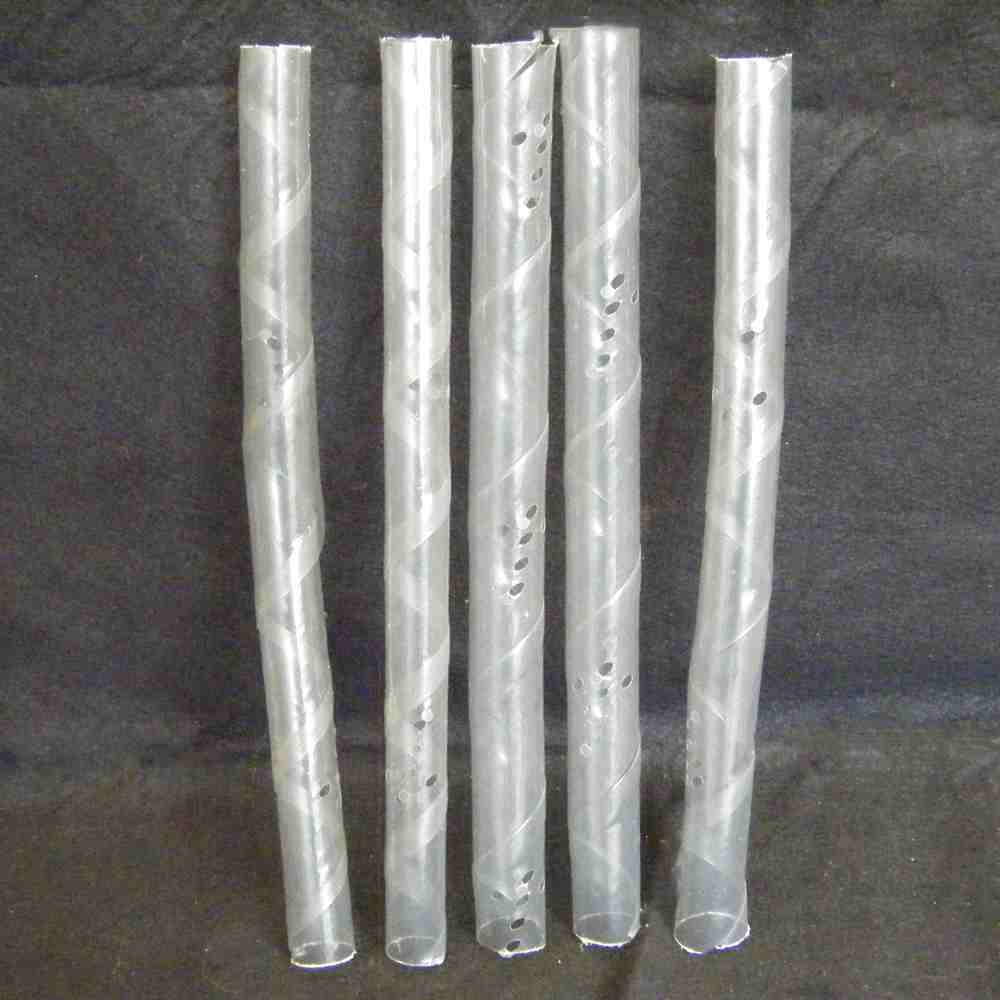
We hope our beginner’s guide provided clear instructions on how to plant bare root hedging and trees. Please keep in mind that a 5% overall failure rate is considered acceptable with bare root planting. However, following the simple guidelines outlined in this guide will significantly increase your chances of successful establishment. When planning your planting density, it’s also wise to factor in the potential failure rate!
Is topiary a good Christmas present? Absolutely! Who wouldn’t love receiving a beautifully sculpted topiary cone, a charming olive tree, or even a topiary footballer? Topiary gifts are unique, eye-catching, and far more lasting than most seasonal presents.
Topiary is the art of trimming trees and shrubs into ornamental shapes like spirals, cones, balls, or even animals. It blends creativity with gardening, adding style and structure to any outdoor space. Unlike perishable gifts, topiary continues to grow and thrive, making it a thoughtful and long-lasting present for garden lovers.
At King & Co, topiary is a true craft. Our skilled team has created everything from topiary corgis and footballers to a full-size Formula One car, which won gold at the Chelsea Flower Show in collaboration with Williams Racing.

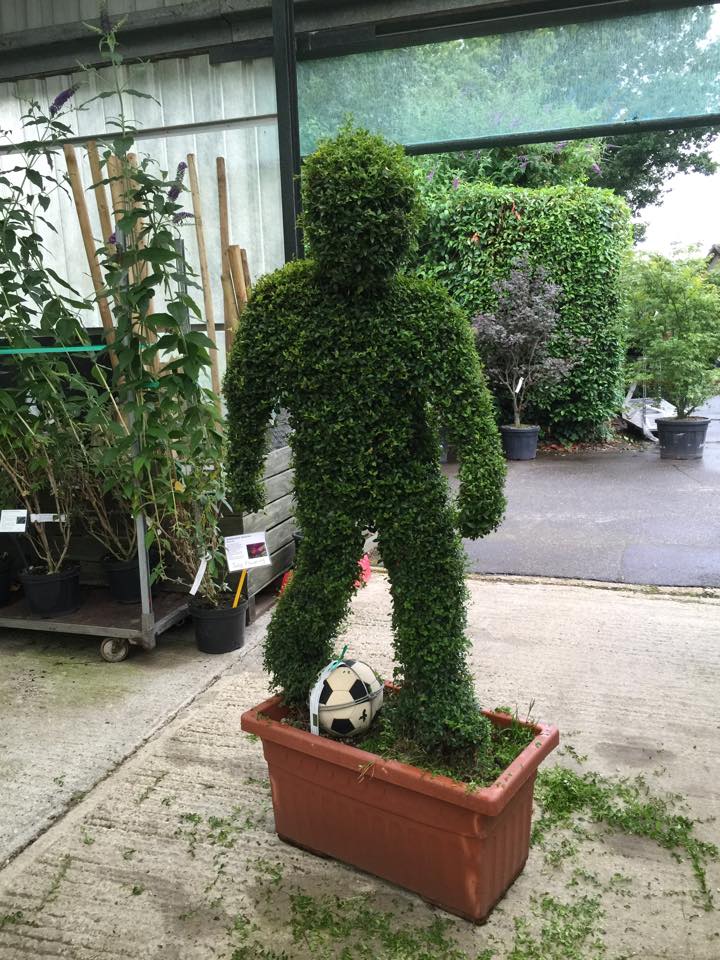
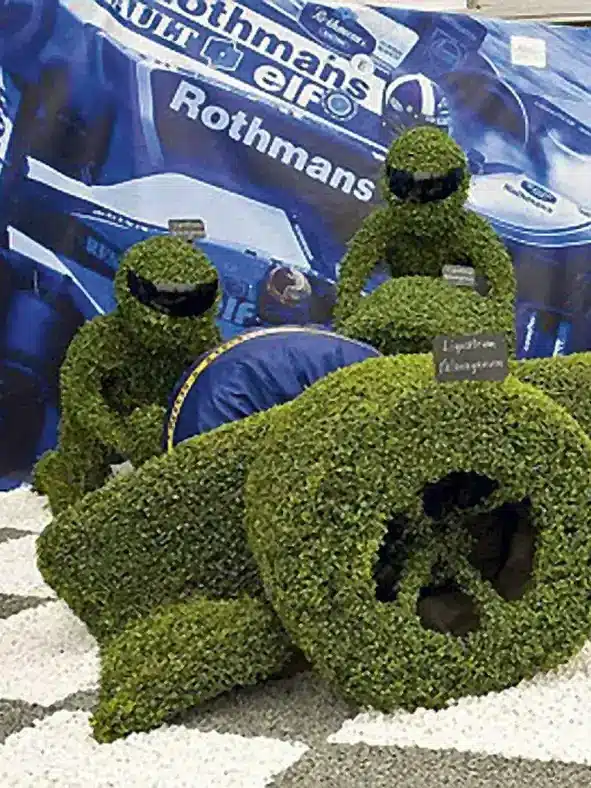
1. 1/2 Standard Trees. These plants make a great Christmas present as they are perfect for framing doorways or creating a welcoming entrance.
Photinia ‘Red Robin’ adds a festive splash of red and green.
Olive trees offer a timeless, Mediterranean look. Great for modern or minimalist gardens.
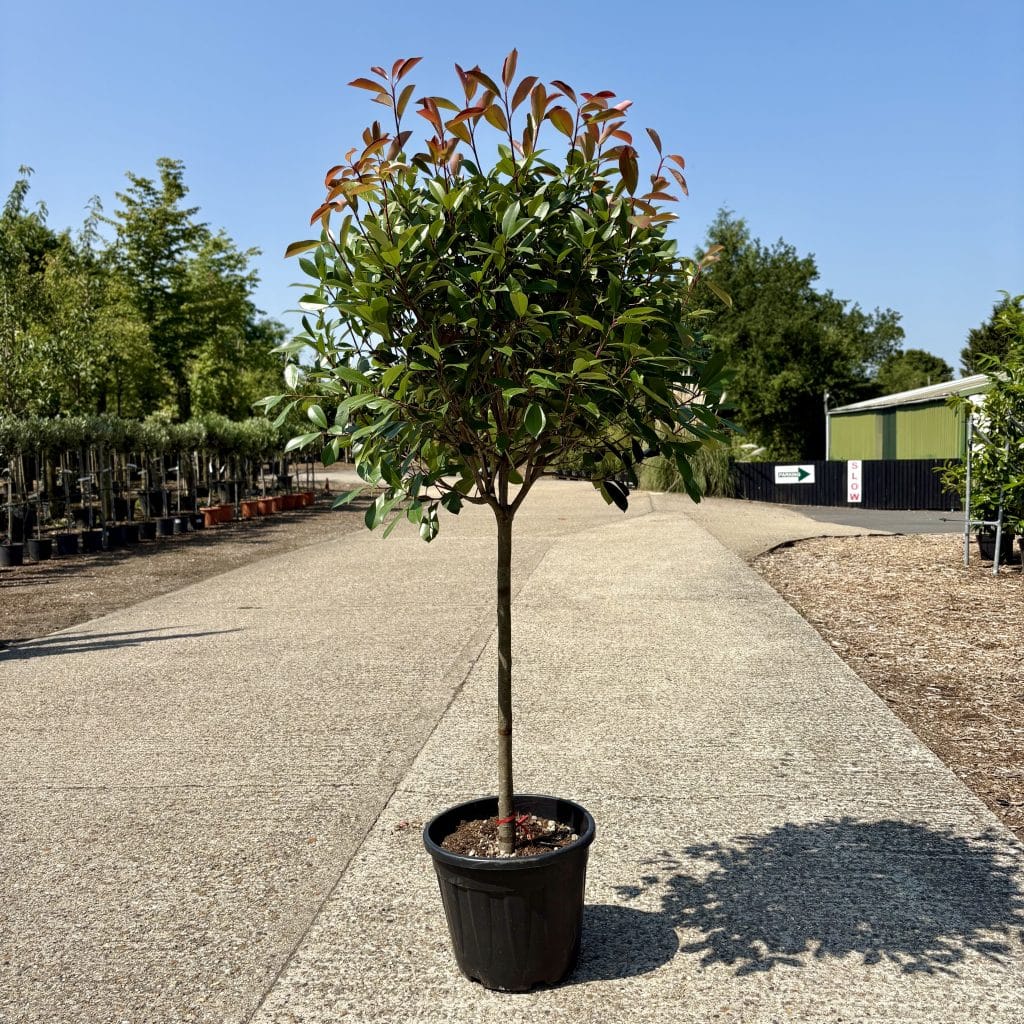

2. Clipped Balls and Cones. These shapes bring structure, elegance, and help define spaces. They are an excellent gift for someone with a formal garden or Italian-inspired landscape. Top choices include: Euonymus ‘Green Spire’, Box-leaved holly, Bay, Photinia, Portuguese laurel and Yew!
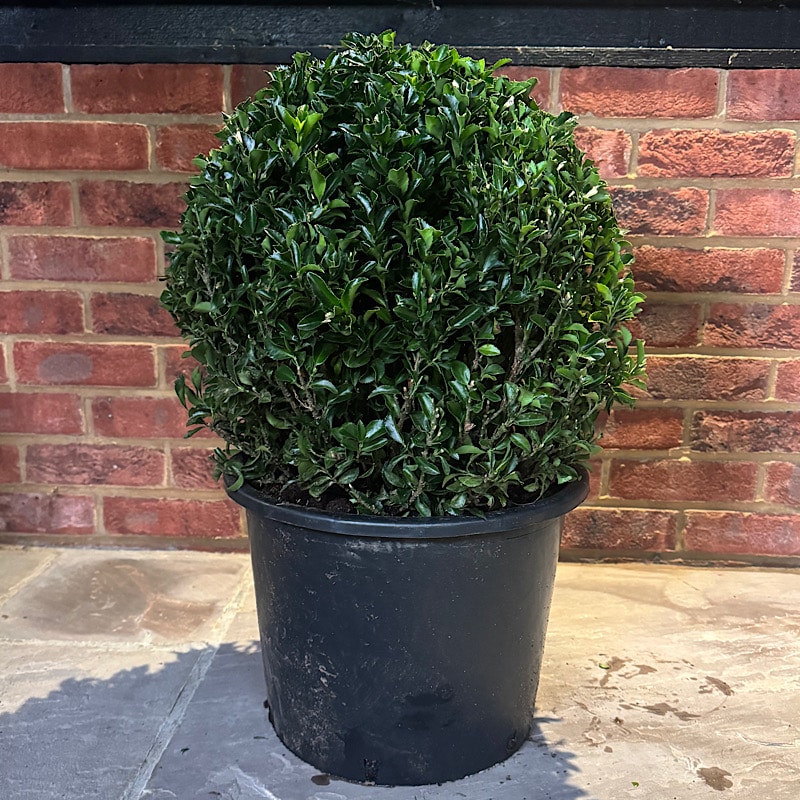
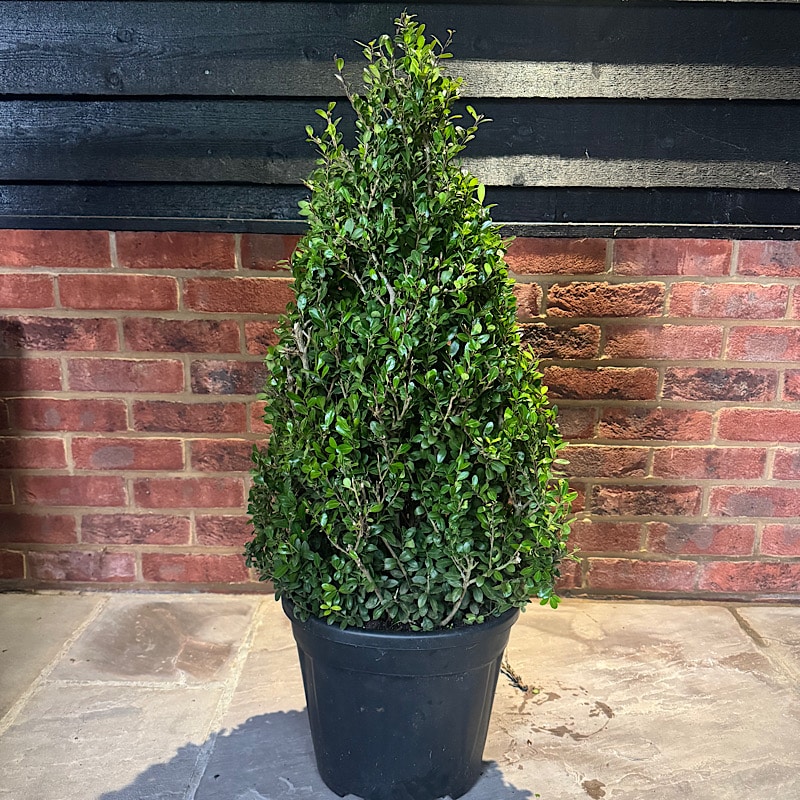
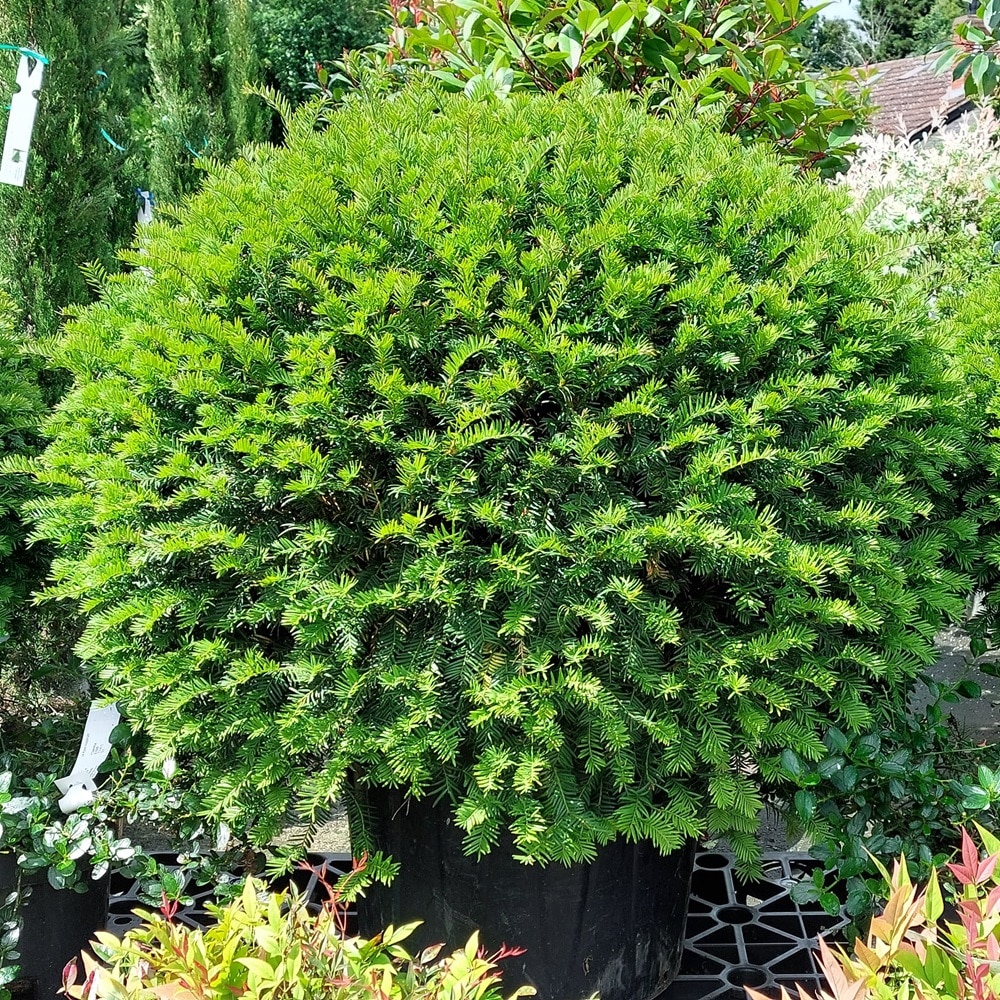
3. Spirals and Pom-Poms. Another gift option for someone with a formal or Italian garden design. Great for adding height and sculptural interest, they also look stunning in containers by entrances. Italian cypress is another candidate for making a bold, upright statement.
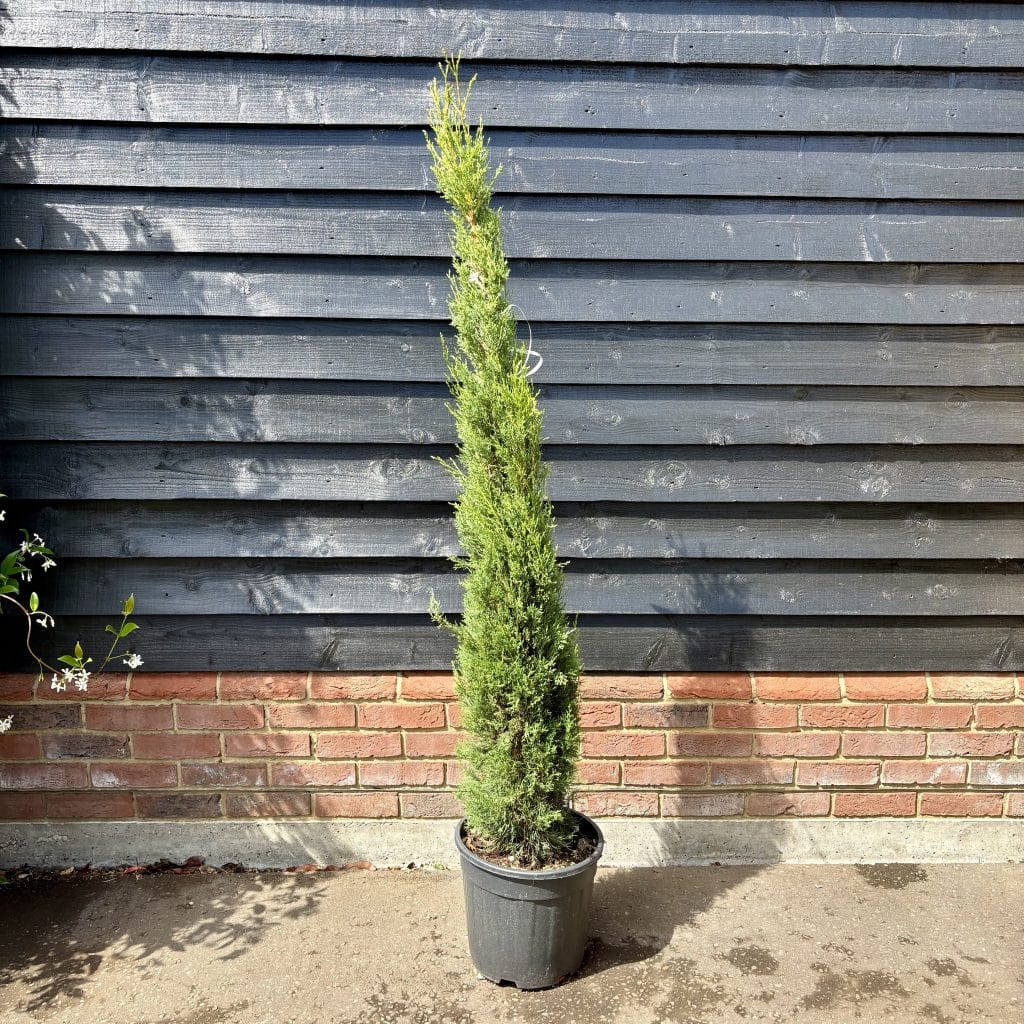
Without a doubt. It’s a gift that combines beauty, creativity, and longevity. Whether you’re buying for a passionate gardener or someone who simply enjoys stylish outdoor spaces, a topiary gift is sure to stand out and be appreciated for years to come.
When does the bare root season start? It’s a question we hear more and more as summer fades and the cooler months approach. The answer isn’t fixed, as the start of the bare root season depends largely on soil temperature. That said, it typically runs from November to March, coinciding with the dormant season. For bare root planting to be successful, the soil must be cool enough to ensure the plants are not actively growing. This is why this season falls firmly within the colder months of the year.
There are various benefits to planting bare root:
Although bare root plants can only be lifted and planted during this dormant period, they offer excellent value compared to container-grown alternatives (which are the only option during the growing season). Because bare root plants are supplied without soil around their roots, they’re lighter and easier to handle (meaning lower delivery costs). With these savings across the board, you can afford to plant more generously, whether that means choosing larger specimens or increasing the quantity to create the impact you’re after.
Bare root plants are much easier to plants as it isn’t as difficult to manoeuvre them around. We also recommend that you plant using the ‘notch planting’ technique as it is a quick process that avoids digging huge planting pits that require laborious backfilling. When ‘notch planting’ you should…
1. ‘Heel in’ tight to ensure good soil/root contact, you should have to tug the plant quite hard to remove it.
2. Make sure that the roots are moist.
3. Open up a slit in the soil, push a spade few inches deep and move back and forward.
4. Slide the root of your bareroot plant into the slit, up to the nursery soil mark.
Don’t remove the hedging plants from the box or bag before you plant. Exposure to sun or drying winds may lead to root desiccation and eventual failure.

It’s important to remember that not all plants are suitable for bare root planting. For instance, Photinia requires soil around its roots and cannot be supplied bare root. At King & Co, we offer only deciduous plants in bare root form, making them an ideal choice for those looking to plant a mixed native or semi-evergreen hedge. Varieties like Hornbeam or Beech work particularly well for semi-evergreen hedging as they often hold onto their brown leaves throughout winter (unless the conditions are particularly harsh). If you’re aiming for a fully evergreen hedge, consider planting smaller P9 Holly or opt for larger, container-grown hedging units instead.
We hope this helped to explain when the bare root season starts. If you have any more questions or would like a quote for a specific project, please contact our sales team!
A Guide to Screening Trees: Is Photinia Good for Natural Privacy?
Bare Root Planting Tips: How to establish a native hedge on a tight budget
A Guide to Pleached Trees: How effective are Hornbeam at creating privacy?
A Guide to Leylandii: Is it good for screening?
What is topiary? Topiary is a timeless art that goes beyond simple trimming. It’s the horticultural craft of sculpting trees and shrubs into ornamental shapes, blending nature with design. This art transforms plants into a variety of forms, from classic spirals to whimsical animals, enhancing any outdoor space.
While topiary originated in ancient Rome, it truly flourished in 17th-century Europe. However, its popularity among English elites saw a sudden decline after satirist Alexander Pope parodied it in The Guardian. Despite this, the craft quietly endured in cottagers’ gardens, where a single, hand-shaped specimen often became a treasured family heirloom.
By the mid-1800s, topiary experienced a strong revival. Victorian garden designers, influenced by writers like Shirley Hibberd, rediscovered its appeal. Hibberd famously stated, “We may not always want the most beautiful natural form, but one of our own design, expressive of our ingenuity.” Topiary also gained popularity during the American Renaissance (1880–1920). It continues to be celebrated today in restored historical gardens as a unique form of green architecture.
Topiary is an excellent choice for homeowners and businesses aiming to enhance their landscapes. Plants such as Chinese privet, Bay, Common Yew, and Box-leaved Holly are frequently selected for this purpose. Their small, dense leaves and naturally compact growth make them ideal for training into various elaborate designs. Whether you are looking for a traditional sphere, an intricate animal shape, or even numbers and letters, topiary adds style, structure, and a unique personality to any environment.
At King & Co, we stock a wide range of topiary including clipped balls and cones, spirals and pom-poms and 1/2 standard trees!
1. Clipped balls. We have a wide range of clipped balls available including varieties like Euonymus ‘Green Spire’, Box-leaved holly, Bay, Photinia, Portuguese laurel and Yew!

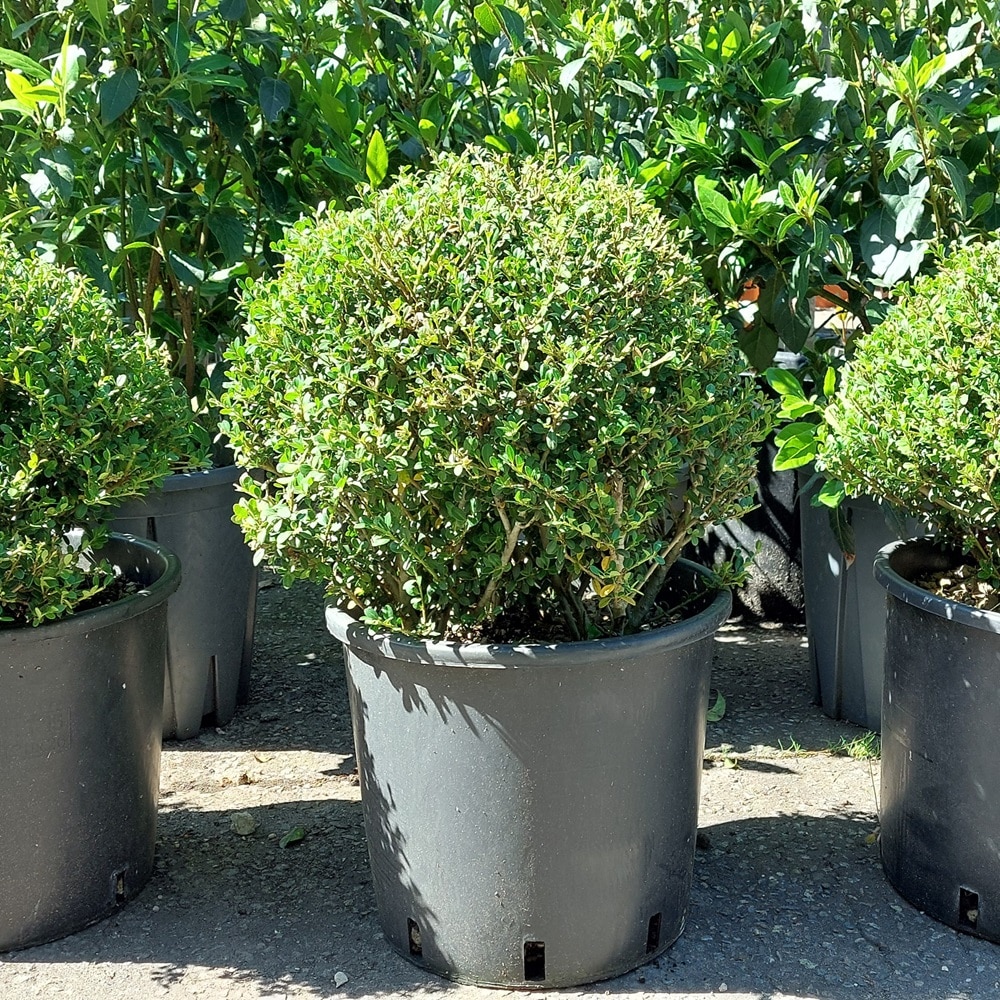

2. Clipped Cones. We also stock Box-leaved holly that has been clipped into a cone shape!
3. Spirals and Pom-Poms. We stock Leyland cypress trees that have been clipped into spiral and pom-pom shape. They make an eye catching architectural feature.
4. Half and Quarter Standard Trees. A fantastic choice for bringing both height and visual interest to smaller gardens. They look particularly striking look when placed near doorways or along driveways.

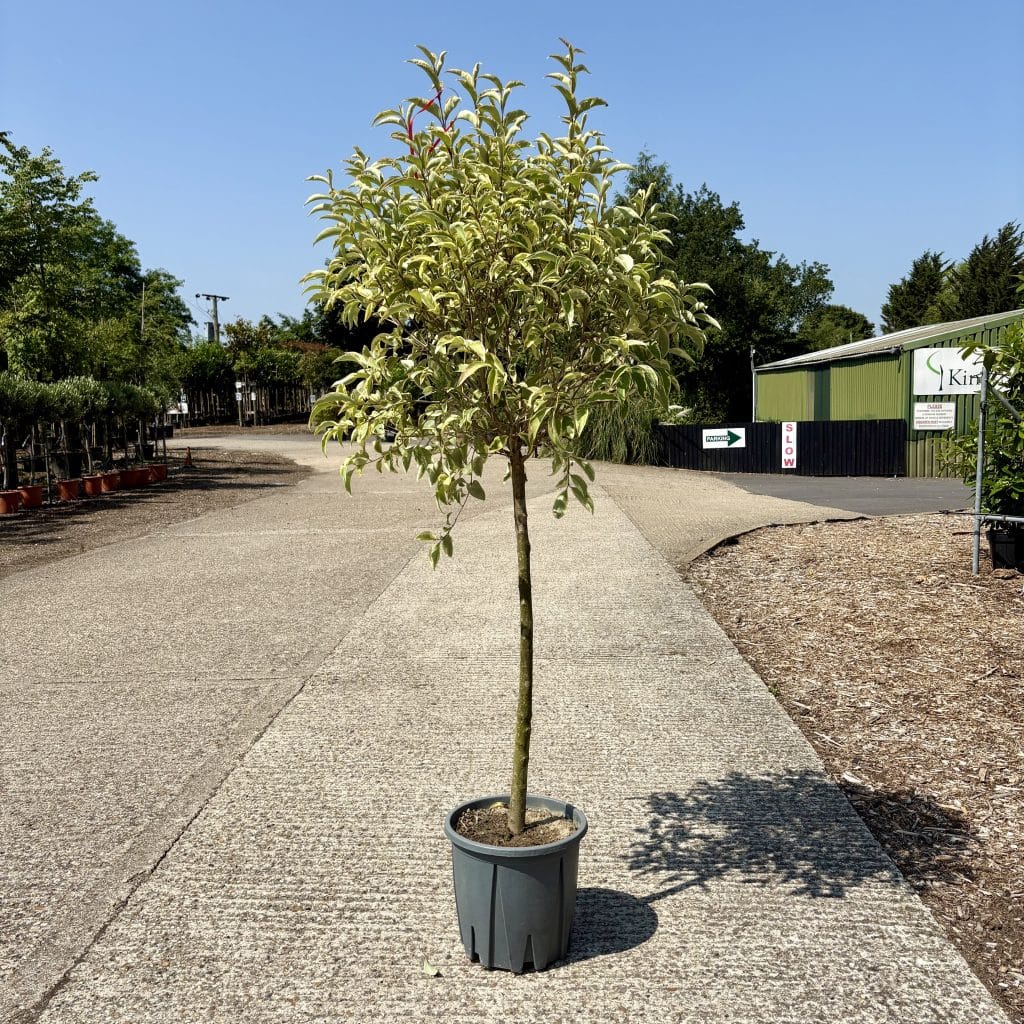

At King & Co, we offer a selection of premium topiary trees and shrubs. From elegant spirals and balls to custom-shaped numbers, our topiary range is perfect for gardens, patios, or commercial spaces. Easy to maintain and visually striking, our topiary products are crafted to impress and built to last.
Whether you’re designing a formal garden or making a bold entrance statement for your business, topiary adds a touch of living art that captivates year-round. So next time someone asks “What is topiary?”, you’ll know it’s not just gardening…it’s artistry, tradition, and creativity, all rolled into one.
2. Best Trees for Privacy: Before and after planting!
3. 10 Trees for Small Gardens!
4. Tree Planting Kits: Give your newly planted tree the best start!
5. How to Water Newly Planted Trees
Are jasmine arches good for summer gardens? Absolutely.
Jasmine (Rhyncospermum jasminoides) is a beautiful evergreen climber that produces clusters of delicate white flowers with a rich, sweet fragrance from mid to late summer. This scent fill the air with a calming aroma, making jasmine the perfect plant for creating a tranquil, inviting atmosphere…especially on warm summer evenings!
At King & Co, we offer jasmine plants trained into elegant arch form. Each arch features a sturdy, plastic-coated metal frame with a double ‘ladder-style’ design. This creates a broader, fuller shape.
The structure is made from two individual plants in separate pots, which slot together at the top to form a beautifully full arch. Once planted, the arch stands approximately 2.2m tall at its peak and 1.5m wide at the base.
Jasmine instantly elevates any outdoor space with its graceful shape and enchanting scent. Practical as well as beautiful, jasmine arches help define different garden zones, add vertical interest, and provide gentle screening without blocking light. They are an excellent choice for placing over a path, framing a doorway, or accenting a patio. The flowers also attract pollinators like bees and butterflies, making them a wildlife-friendly addition to your garden.
Jasmine is a great choice for summer gardens! If you’re seeking a fragrant feature with real impact, a jasmine arch should be high on your wish list. Come and see them for yourself at our Tree Nursery in Rayne, Essex, just off the A120 and within easy reach of the M11. We also stock smaller jasmine climbers and espalier forms, available to order online with convenient home delivery.
2. Best Trees for Privacy: Before and after planting!
3. 10 Trees for Small Gardens!
4. Tree Planting Kits: Give your newly planted tree the best start!
5. How to Water Newly Planted Trees
How Did a Topiary F1 Car Win Gold at the Chelsea Flower Show? Here Paul King, owner of King and Co, has walked through the intricacies of our Gold Medal-winning topiary creation!
King and Co partnered with Williams F1 to create this ambitious installation celebrating the team’s 35-year history. The award-winning display turned heads with its life-size scale and precise detailing.
First unveiled in 2012, the project took three years to complete. The topiary car featured a fully formed pit-stop backdrop and included authentic parts from Williams Racing. The team sculpted the entire piece from Ligustrum delavayanum.
‘From a professional point of view it’s utopia. ‘We thought the judges may not feel it was a Chelsea-type thing but we’re so happy we’ve achieved a level of excellence that’s so hard to achieve.’
Designer and Owner of King and Co, Paul King
The display’s pit scene was shaped using Chinese privet, a fast-growing species ideal for detailed topiary work. Regular clipping of Ligustrum delavayanum encourages dense, compact foliage. This was perfect for sculpting complex shapes like the intricate curves of F1 tyre side pods. The plant’s versatility made it a natural choice for this unique challenge!
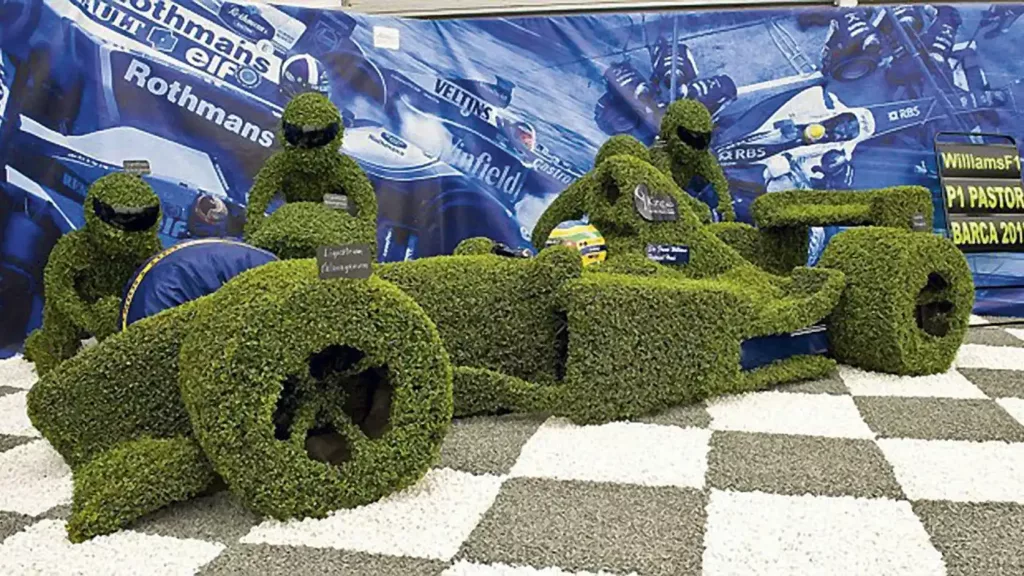
Sir Frank Williams, founder of Williams F1, visited the show on Monday, 21st May. Shortly after his team’s victory at the Spanish Grand Prix.
We were fortunate enough to get a gold medal for it, which Sir Frank was delighted about, because he likes winning things.”
Designer and Owner of King and Co, Paul King
Following the display’s success at Chelsea, several topiary pit scenes have since been installed at the Williams Racing factory in Oxfordshire!
Back at our nursery, we offer a wide selection of topiary plants for immediate collection or next-day delivery across the UK. Whether you’re after instant impact with ready-made hedging, cones, spirals, balls, pleached trees, or dramatic arches, we provide topiary options to suit every style. We also stock high-quality alternatives to traditional Box plants, as well as Yew hedging, long favoured in classic topiary design.
BBC – Williams F1 Car Topiary Exhibit Wins Chelsea gold
The Telegraph – Hedges Cut Like Williams Formula 1 Car
Top Gear – F1 Garden Wins Chelsea Flower Show
Daily Mail – British Racing Green: The Hedge Shaped Like a Formula 1 Car
Financial Times – Formula One: Racing Green
You can buy trees, hedging, shrubs and topiary online by browsing our website.
If you do not see a plant or size that is suitable for you then please call as we stock a wide variety of plants in our tree nursery. It’s worth noting that many other websites sell other people’s stock (i.e. they act as an agent) so you cannot view the products at their own site. At King & Co, all of our advertised plants are available for viewing at our tree nursery in Rayne, near Braintree, situated just over an hours drive out of London.
Our knowledgeable and experienced tree nursery staff are always contactable via phone on 01376 340469 or if you have any questions regarding any of our trees or accessories.
If you cannot see what you require on our website, please complete the enquiry form. We will give it our urgent attention and will get back to you shortly with a solution that meets your needs.

If you are looking for specific evergreen trees, Photinia, Leylandii hedging, Leylandii trees, instant hedging or shrubs, use the search bar at the top of the page